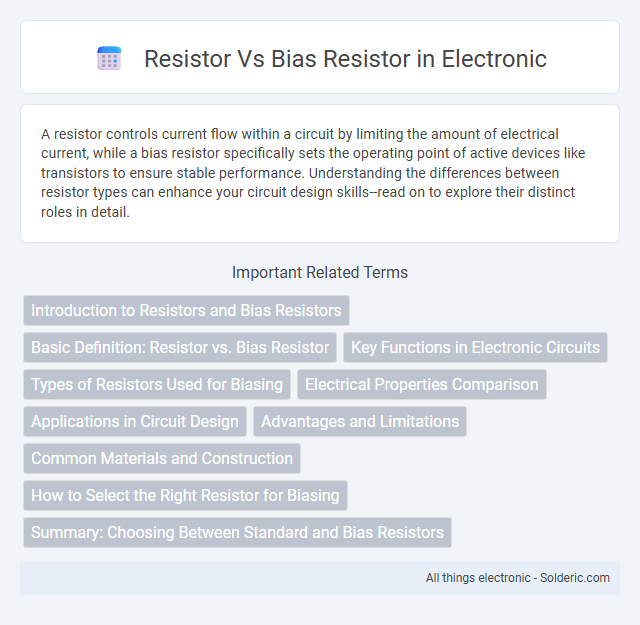A resistor controls current flow within a circuit by limiting the amount of electrical current, while a bias resistor specifically sets the operating point of active devices like transistors to ensure stable performance. Understanding the differences between resistor types can enhance your circuit design skills--read on to explore their distinct roles in detail.
Comparison Table
| Feature | Resistor | Bias Resistor |
|---|---|---|
| Definition | Passive electrical component that limits current flow. | Resistor used specifically to establish a stable voltage or current in transistor circuits. |
| Main Function | Controls current and divides voltage. | Sets operating point (bias) of active devices like transistors. |
| Application | Used in various circuits for current limiting, voltage division, timing, etc. | Common in amplifier circuits, transistor biasing, and signal conditioning. |
| Placement | Variable, depends on circuit design. | Connected to transistor base, emitter, or collector for biasing purposes. |
| Role in Circuit | General passive component for controlling electrical parameters. | Critical for ensuring transistor operates in desired region (active region). |
Introduction to Resistors and Bias Resistors
Resistors regulate electrical current in circuits by providing consistent resistance, while bias resistors specifically set the operating point of active components like transistors. Bias resistors ensure proper voltage and current levels to maintain stable performance in amplifiers and switching circuits. Understanding the distinction helps you design and optimize electronic circuits with precise control over device behavior.
Basic Definition: Resistor vs. Bias Resistor
A resistor is a passive electrical component that limits the flow of current and drops voltage within a circuit. A bias resistor, specifically, is used to set the operating point of an active device such as a transistor by providing a stable voltage or current. While general resistors control current broadly, bias resistors precisely establish conditions for proper device function in amplification or switching applications.
Key Functions in Electronic Circuits
A resistor limits current flow and divides voltage, ensuring stable operation of electronic components. A bias resistor sets the operating point of active devices like transistors, stabilizing gain and preventing signal distortion. Understanding the distinct roles of these resistors helps optimize your circuit's performance and reliability.
Types of Resistors Used for Biasing
Bias resistors commonly include fixed, variable, and precision resistors designed to maintain stable voltage and current levels in circuits. Fixed resistors such as carbon film and metal oxide types provide consistent resistance, while variable resistors like potentiometers enable adjustable biasing for optimal transistor operation. Your choice of resistor depends on the required tolerance, temperature stability, and circuit design to ensure reliable biasing performance.
Electrical Properties Comparison
Resistors exhibit a fixed resistance value to limit current flow and drop voltage in circuits, characterized by parameters such as tolerance, power rating, and temperature coefficient. Bias resistors, a specialized type of resistor, are used to set the operating point of active devices like transistors, ensuring stable current and voltage in the biasing network with precision-controlled resistance values. The key electrical properties differentiating bias resistors include high stability and low noise to maintain consistent device performance under varying temperature and signal conditions.
Applications in Circuit Design
Resistors serve as fundamental components in circuit design to limit current, divide voltage, and protect sensitive components. Bias resistors specifically control the operating point of transistors or other active devices, ensuring stable performance within amplifiers and switching circuits. Proper selection and placement of bias resistors are critical for achieving desired gain, linearity, and device longevity in analog and digital electronic systems.
Advantages and Limitations
Resistors provide consistent resistance to control current flow, ensuring predictable circuit operation with simple design and low cost; however, they cannot adjust voltage levels dynamically. Bias resistors specifically set the operating point of active devices like transistors, offering improved stability in amplification and switching while potentially introducing increased power consumption and complexity. Your choice depends on whether fixed current control or precise device biasing is critical for your circuit performance.
Common Materials and Construction
Resistors and bias resistors are commonly made from materials like carbon film, metal film, and metal oxide, with carbon film offering cost-effectiveness and metal film providing higher precision. The construction of standard resistors involves a resistive element coated on a ceramic core, whereas bias resistors often prioritize stability and noise reduction by using metal film or wire-wound materials to handle specific current and voltage conditions. Both types use similar substrates but differ in tolerance and thermal properties to meet their distinct roles in electrical circuits.
How to Select the Right Resistor for Biasing
Selecting the right resistor for biasing involves calculating the required base current and consulting the transistor's datasheet to determine its current gain (hFE or b). Choose a resistor value that ensures the transistor operates in the desired region, typically by applying the formula Rb = (Vinput - Vbe) / Ib, where Vbe is the base-emitter voltage (usually around 0.7V for silicon transistors) and Ib is the base current. High-precision metal film resistors are often preferred for biasing applications due to their low tolerance and thermal stability, ensuring consistent transistor performance.
Summary: Choosing Between Standard and Bias Resistors
Standard resistors regulate current flow within electrical circuits by providing specific resistance values, essential for controlling voltage and current levels. Bias resistors, often used in transistor circuits, establish a stable operating point by setting the base or gate voltage, ensuring consistent device performance. Selecting between standard and bias resistors depends on circuit requirements: standard resistors prioritize general current limitation, while bias resistors focus on stabilizing active components like transistors for optimal operation.
resistor vs bias resistor Infographic

 solderic.com
solderic.com